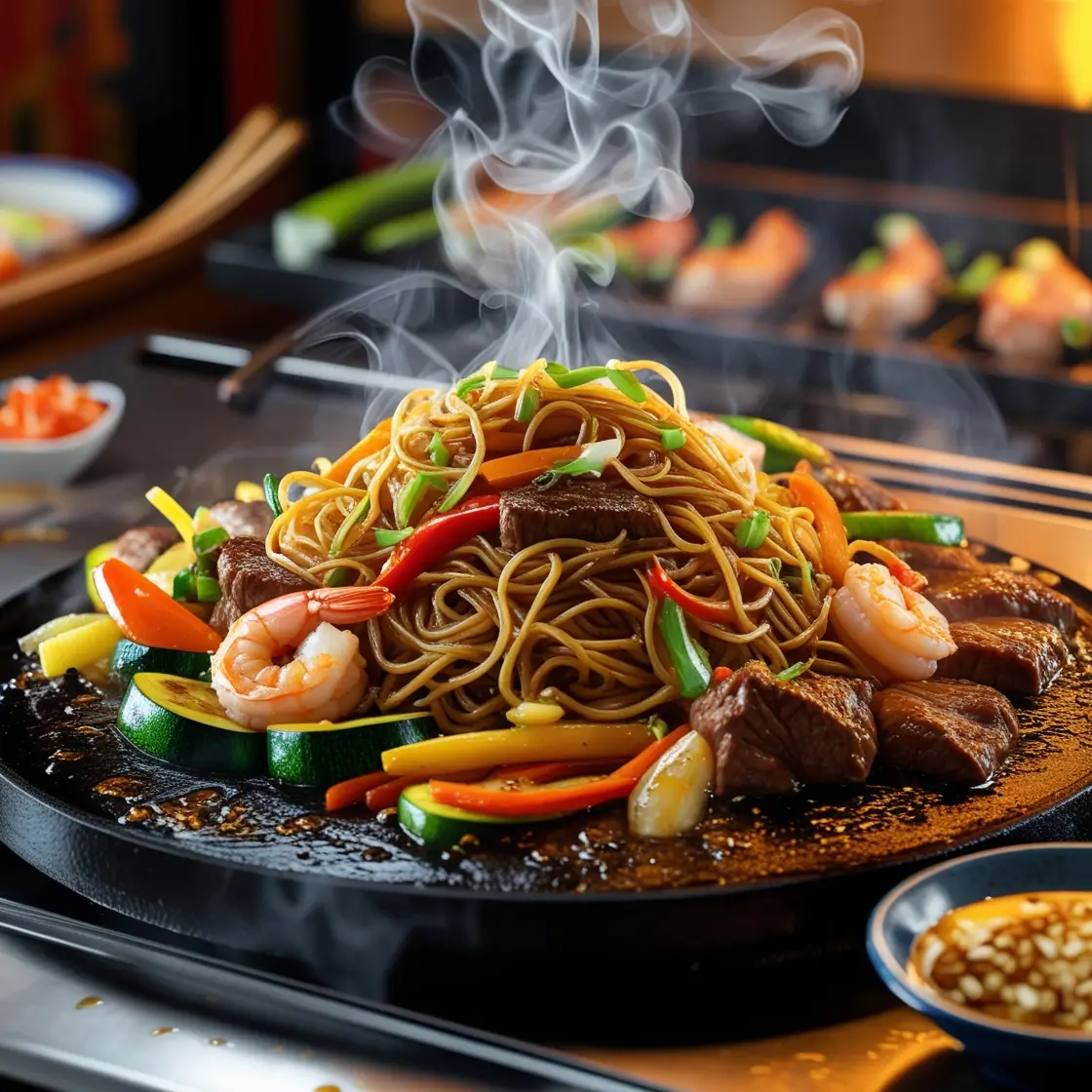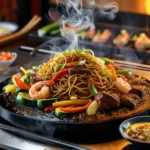Introduction :
Hibachi noodles have gained widespread popularity recently, often seen in Japanese-inspired restaurants or home kitchens. This dish’s perfect blend of flavours, textures, and fresh ingredients makes it a favourite among noodle lovers worldwide. Whether dining out or preparing it at home, Hibachi-style stir-fried noodles offer a satisfying and customizable meal. In this article, we’ll explore this dish’s definition, origin, and cooking process while delving into its nutritional value and key ingredients that make it truly special.
Definition and Origin of Hibachi Noodles
Hibachi-style restaurants typically serve stir-fried noodles, a noodle dish cooked on an open flame. The word “Hibachi” refers to a traditional Japanese cooking method involving grilling food, often right in front of diners, where chefs prepare meals on a flat grill. The noodles are sautéed with various fresh vegetables, proteins, and flavorful sauces.
Originating from Japanese cuisine, these noodles offer a fusion of simple yet bold tastes, such as soy sauce, garlic, and sesame oil. Over time, other cultures have adapted this dish, incorporating various ingredients to suit local preferences. For a deeper dive into the traditional Hibachi cooking methods, check out this detailed article on Hibachi cooking.
Roots of Hibachi Cuisine in Japanese Culture
The roots of Hibachi cuisine lie deeply within Japanese culinary traditions. Originally, the Hibachi grill was a small, portable heating device used to cook food. People primarily used it for grilling meat, fish, and vegetables during social gatherings or special occasions. The unique cooking style, emphasising precision and skill, quickly became an iconic feature of Japanese dining experiences.
In Hibachi-style restaurants, chefs prepare food right in front of the customers using a large griddle or grill, providing a spectacular dining experience. This method uses high-heat grilling with minimal oil, ensuring the food tastes fresh and flavorful.
For a deeper dive into the various ways Hibachi noodles can be styled, check out this comprehensive noodle guide for tips on customizing flavors.
Common Ingredients in Hibachi Noodles
When preparing Hibachi noodles, the ingredients used are both simple and fresh. The common components include:
- Noodles: The base of the dish, usually made from wheat flour, offers a chewy texture.
- Vegetables: Common choices include finely chopped onions, bell peppers, carrots, zucchini, and broccoli.
- Protein: Options like shrimp, chicken, beef, or tofu add flavour and variety to the dish.
- Sauces: Soy sauce, teriyaki sauce, sesame oil, and oyster sauce bring rich umami and depth.
- Seasonings: Garlic, ginger, and green onions frequently elevate the flavour profile.
These ingredients combine to create a balanced dish that’s both savoury and satisfying. The choice of vegetables and proteins can vary depending on personal taste or dietary preferences.

Step-by-Step Cooking Process
Preparing these stir-fried noodles is an easy and enjoyable, even for beginners. Here’s a simple guide to cooking Hibachi noodles at home:
- Prepare the Noodles
Start by boiling the noodles in water until they reach an al dente texture. Drain and set aside. - Heat the Grill or Pan
Use a large frying pan or wok. Heat a little sesame oil or vegetable oil over medium-high heat. - Cook the Protein
Add your choice of protein—chicken, beef, or shrimp—and cook until browned and fully cooked. Remove and set aside. - Sauté Vegetables
Add the chopped vegetables (onions, bell peppers, carrots) to the pan. Sauté for a few minutes until tender but still crisp. - Add the Noodles
Return the cooked noodles to the pan. Stir everything together, ensuring the noodles are well coated with the vegetables and protein. - Flavouring
Pour in soy sauce, sesame oil, and other sauces. Add garlic, ginger, and green onions for an extra punch of flavour. Stir-fry until everything is evenly mixed and heated through. - Serve
Serve hot, garnished with extra green onions or sesame seeds if desired. Enjoy your meal!
Nutritional Value of Hibachi Noodles
These noodles offer a balanced meal with carbohydrates, protein, and healthy fats. While the exact nutritional value can vary depending on ingredients and portion size, here’s a general breakdown:
- Calories: A standard serving contains 300–400 calories, depending on the protein and sauce used.
- Carbohydrates: Noodles provide 40-50g of carbs per serving.
- Protein: Depending on the protein choice, it can contain 20-30g of protein.
- Fats: Healthy fats contribute 10-15g per serving.
- Vitamins & Minerals: Vegetables like bell peppers, carrots, and broccoli offer vitamins A, C, and K, as well as potassium and iron.
Hibachi noodles can be nutritious when prepared with fresh, healthy ingredients. However, watch portion sizes and be mindful of sauces, as they may increase sodium and sugar content.
Classic Hibachi Noodles Recipe
A traditional version of this dish focuses on simplicity, showcasing the flavorful ingredients. Here’s a recipe to try:
Ingredients:
- 2 cups cooked ramen or egg noodles
- 1 cup sliced chicken breast or shrimp
- 1 small onion, sliced
- 1/2 bell pepper, sliced
- 1/4 cup soy sauce
- 1 tbsp sesame oil
- 2 tbsp oyster sauce
- 1 tbsp chopped garlic
- 1/4 tsp ground black pepper
- 1 tbsp green onions (for garnish)
Instructions:
- Heat sesame oil in a wok over medium-high heat.
- Add chicken or shrimp and cook until browned.
- Toss in onions, bell peppers, and garlic, sautéing until soft.
- Stir in noodles, soy sauce, oyster sauce, and black pepper. Stir to combine.
- Garnish with green onions and serve immediately.
If you’re wondering how to add more dimension to your dish, try pairing the noodles with buttered egg noodles for a creamy, indulgent twist.

Best Side Dishes to Serve with Hibachi Noodles
Pairing the right side dishes enhances the flavour profile of Hibachi noodles. Here are some excellent options:
- Grilled Vegetables: Bell peppers, zucchini, and asparagus add a smoky flavour that complements the noodles.
- Fried Rice: A classic pairing that balances the richness of the noodles with its egg and vegetable components.
- Miso Soup: A light soup provides a refreshing contrast to the richness of the noodles.
- Spring Rolls: Crispy rolls filled with vegetables or meat provide a crunchy texture that complements the noodles.
Discover unique ideas in this Asian-inspired noodle recipe that pairs beautifully with seafood.
Conclusion :
In conclusion, Hibachi noodles are a delicious and versatile dish, easily customizable to suit your tastes. Whether served with grilled vegetables, fried rice, or miso soup, the perfect sides can complement the rich flavours of the noodles. You can create Hibachi noodles that rival those served in top Hibachi restaurants by mastering the cooking process and grilling techniques.
FAQ:
What kind of noodles are hibachi noodles?
Are hibachi noodles healthy?
Hibachi noodles are often sautéed in butter and mixed with sauces containing sugar and sodium, making them flavorful but calorie-dense. Consuming them occasionally is fine, but regular indulgence may not align with a health-conscious diet.
Is hibachi sweet or salty?

Discover the Secrets to Perfect Hibachi Noodles: Tips, Sides, and FAQs
- Total Time: 25 minutes
- Yield: 4 servings 1x
Description
Learn how to make perfect Hibachi Noodles, the best side dishes to pair, expert cooking tips, and answers to popular FAQs.
Ingredients
- 8 oz yakisoba, ramen, or linguine noodles
- 1 tbsp sesame oil
- 2 tbsp unsalted butter
- 3 tbsp soy sauce
- 2 tbsp oyster sauce
- 1 tbsp teriyaki sauce
- 1 tbsp sugar
- 1 tsp garlic, minced
- 1/2 cup sliced onions
- 1/2 cup sliced bell peppers
- 1/2 cup shredded carrots
- 1/4 cup sliced green onions (for garnish)
- 1 tbsp sesame seeds (optional, for garnish)
Instructions
Cook the Noodles:
- Bring a pot of salted water to a boil and cook the noodles according to the package instructions. Drain and set aside.
Prepare the Sauce:
- In a small bowl, whisk together soy sauce, oyster sauce, teriyaki sauce, and sugar. Set aside.
Sauté Vegetables:
- Heat sesame oil in a large skillet or wok over medium-high heat. Add onions, bell peppers, carrots, and minced garlic. Sauté for 2-3 minutes until tender but still crisp.
Add Noodles and Sauce:
- Add the cooked noodles to the skillet with the sautéed vegetables. Pour the prepared sauce over the noodles and toss to coat evenly.
Finish with Butter:
- Add unsalted butter to the skillet and stir until melted and incorporated, giving the noodles a rich, glossy finish.
Garnish and Serve:
- Transfer the Hibachi noodles to a serving platter. Garnish with sliced green onions and sesame seeds. Serve hot as a main course or alongside grilled vegetables or proteins.
Notes
- Variations: Add shrimp, chicken, or beef for a protein boost. Vegetarians can add tofu or extra vegetables.
- Storage: Store leftovers in an airtight container in the refrigerator for up to 3 days. Reheat in a skillet with a splash of water or soy sauce to refresh the flavors.
- Customizations: Adjust the sweetness or saltiness by modifying the amount of sugar and soy sauce in the recipe.
- Prep Time: 10 minutes
- Cook Time: 15 minutes
- Category: Lunch
- Cuisine: Japanese-inspired
Nutrition
- Serving Size: 1 cup of noodles
- Calories: 280
- Sodium: 750mg
- Fat: 12g
- Carbohydrates: 35g
- Protein: 6g
Keywords: Hibachi noodles, Japanese-inspired noodles, easy hibachi noodle recipe, stir-fried noodles, yakisoba noodles, homemade hibachi noodles, hibachi-style stir fry, noodle side dish, hibachi dinner recipe, vegetarian hibachi noodles, hibachi sauce recipe, teriyaki noodles, soy sauce noodles, sesame noodles, hibachi noodle variations.

9 thoughts on “Discover the Secrets to Perfect Hibachi Noodles: Tips, Sides, and FAQs”
Comments are closed.